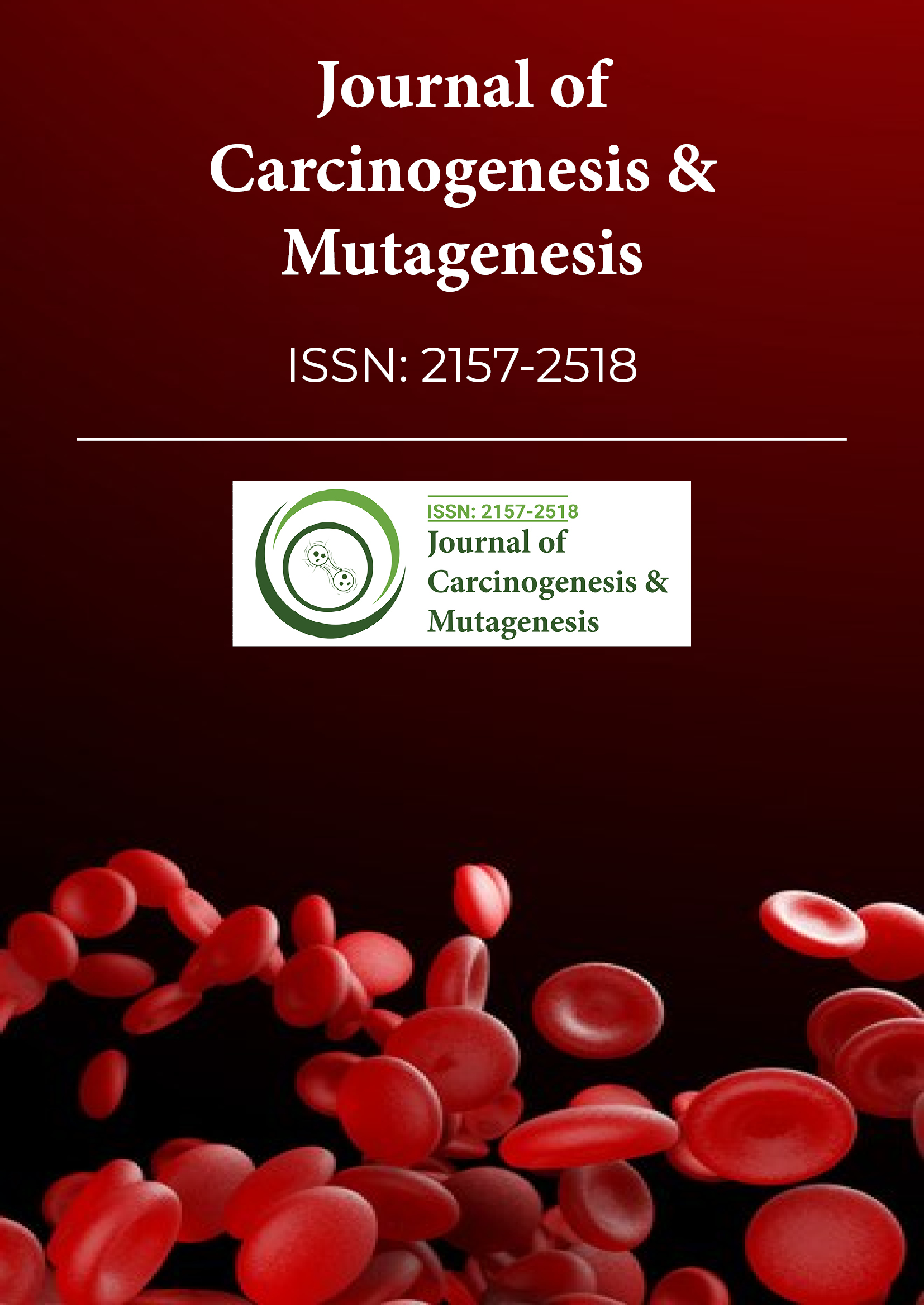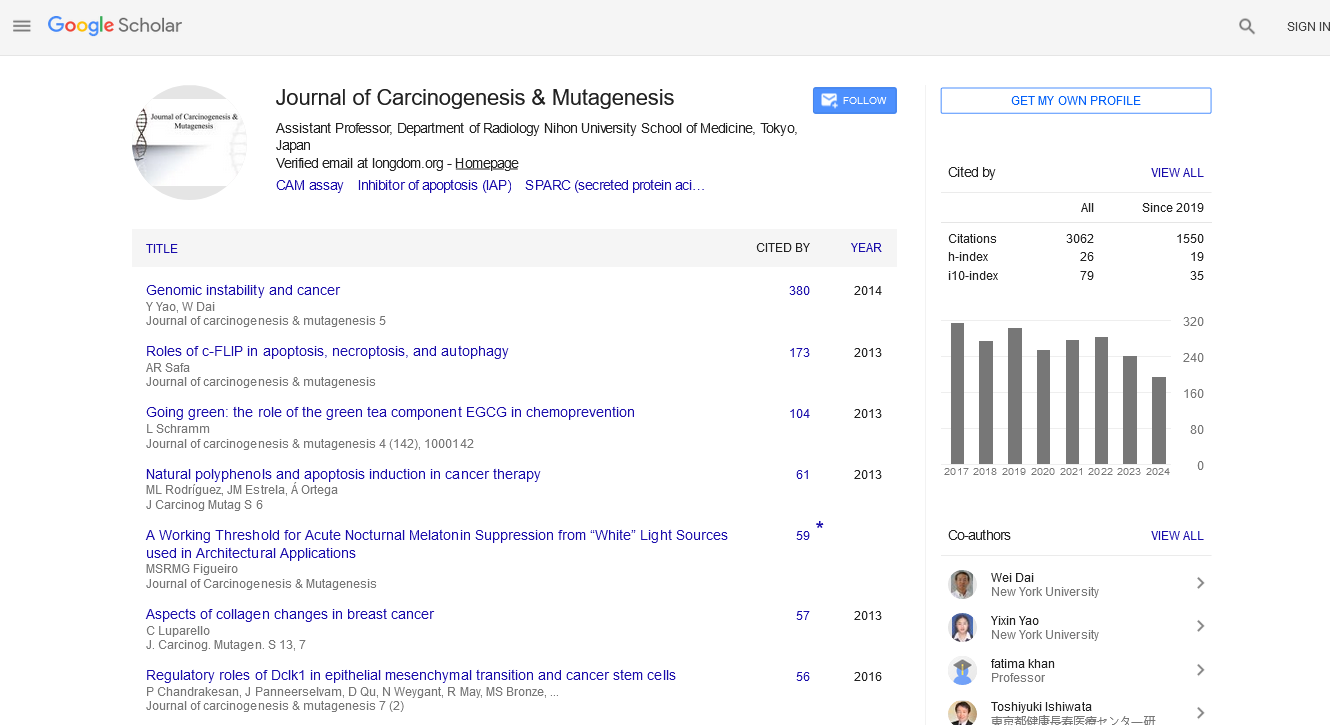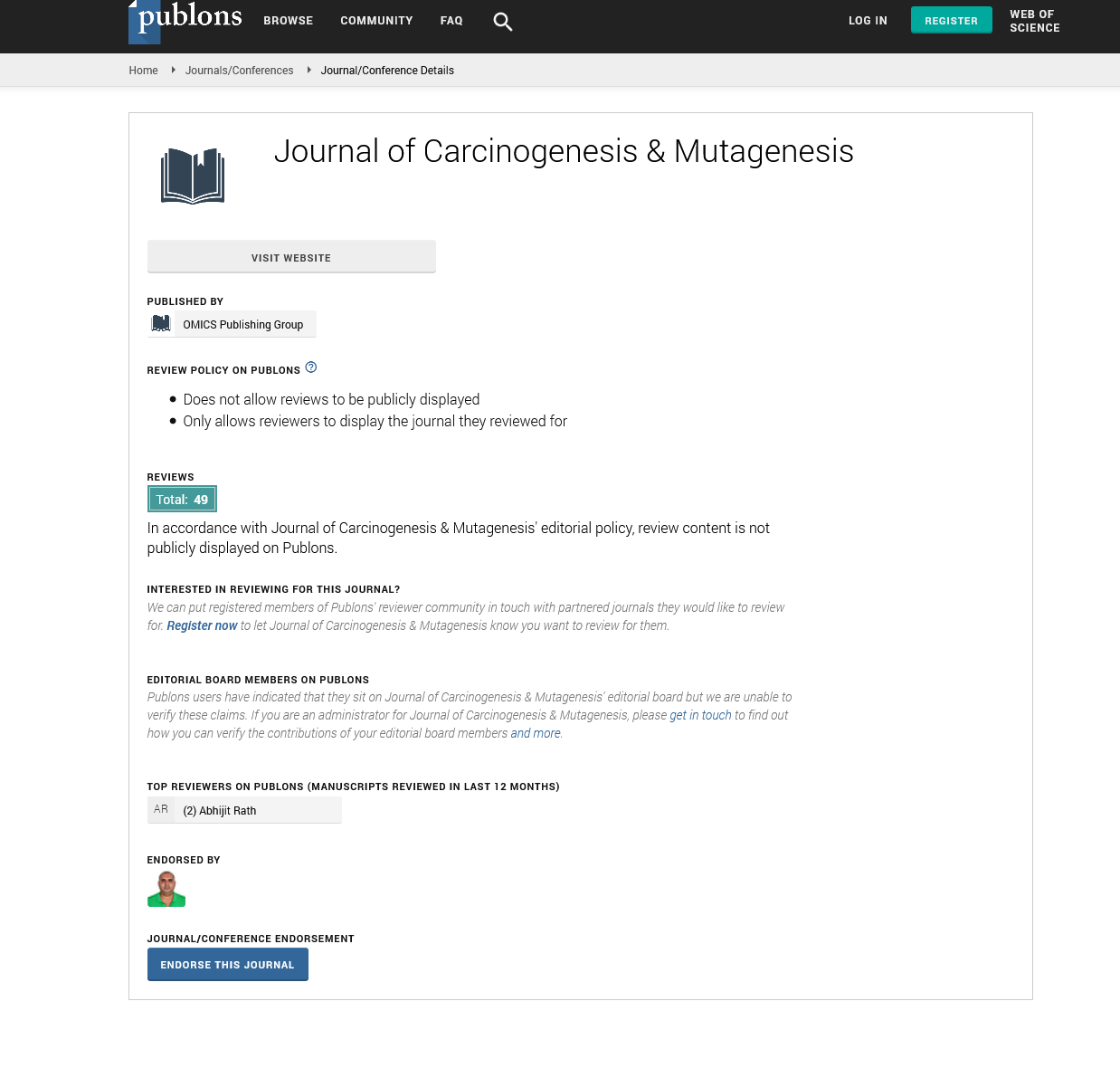Indexed In
- Open J Gate
- Genamics JournalSeek
- JournalTOCs
- Ulrich's Periodicals Directory
- RefSeek
- Hamdard University
- EBSCO A-Z
- OCLC- WorldCat
- Publons
- Geneva Foundation for Medical Education and Research
- Euro Pub
- Google Scholar
Useful Links
Share This Page
Journal Flyer

Open Access Journals
- Agri and Aquaculture
- Biochemistry
- Bioinformatics & Systems Biology
- Business & Management
- Chemistry
- Clinical Sciences
- Engineering
- Food & Nutrition
- General Science
- Genetics & Molecular Biology
- Immunology & Microbiology
- Medical Sciences
- Neuroscience & Psychology
- Nursing & Health Care
- Pharmaceutical Sciences
Articles published in Journal of Carcinogenesis & Mutagenesis have been cited by esteemed scholars and scientists all around the world. Journal of Carcinogenesis & Mutagenesis has got h-index 26, which means every article in Journal of Carcinogenesis & Mutagenesis has got 26 average citations.
Following are the list of articles that have cited the articles published in Journal of Carcinogenesis & Mutagenesis.
| 2024 | 2023 | 2022 | 2021 | 2020 | 2019 | 2018 | 2017 | 2016 | 2015 | 2014 | 2013 | 2012 | 2011 | 2010 | |
|---|---|---|---|---|---|---|---|---|---|---|---|---|---|---|---|
Total published articles |
59 | 58 | 60 | 60 | 35 | 15 | 21 | 27 | 37 | 47 | 82 | 64 | 25 | 16 | 13 |
Research, Review articles and Editorials |
7 | 10 | 10 | 17 | 15 | 14 | 17 | 26 | 14 | 29 | 63 | 39 | 14 | 14 | 9 |
Research communications, Review communications, Editorial communications, Case reports and Commentary |
38 | 50 | 50 | 43 | 45 | 0 | 3 | 0 | 23 | 15 | 19 | 12 | 8 | 1 | 2 |
Conference proceedings |
0 | 0 | 0 | 0 | 0 | 31 | 24 | 0 | 0 | 0 | 0 | 0 | 0 | 0 | 0 |
Citations received as per Google Scholar, other indexing platforms and portals |
186 | 241 | 283 | 277 | 255 | 303 | 276 | 316 | 311 | 226 | 113 | 99 | 31 | 99 | 0 |
| Journal total citations count | 3062 |
| Journal impact factor | 3.02 |
| Journal cite score | 12.43 |
| Journal h-index | 26 |
Important citations
Chu JH, Hart JE, Chhabra D, Garshick E, Raby BA, et al. (2016) Gene expression network analyses in response to air pollution exposures in the trucking industry. Environmental Health. 15: 101.
Marom-Haham L, Shulman A (2016) Cigarette smoking and hormones. Current Opinion in Obstetrics and Gynecology 28: 230-235.
Huan T, Joehanes R, Schurmann C, Schramm K, Pilling LC, et al. (2016) A Whole-Blood Transcriptome Meta-Analysis Identifies Gene Expression Signatures of Cigarette Smoking. Human Molecular Genetics. 9: ddw288.
Poussin C, Belcastro V, Martin F, Boué S, Peitsch MC, et al. (2017) Crowd-sourced verification of computational methods and data in systems toxicology: a case study with a heat-not-burn candidate modified risk tobacco product. Chemical Research in Toxicology. 9: 1.
Volko CD, Rohr UD (2015) Can Plants’ Ability for DNA Repair and Stress Defense be Used against Patients’ Circulating Tumor Cells?. Journal of Pharmacy and Nutrition Sciences. 5:157-178.
Vink JM, Jansen R, Brooks A, Willemsen G, Grootheest G, et al. (2015) Differential gene expression patterns between smokers and nonâ€smokers: cause or consequence?. Addiction biology. 1: 2.
Bauer M, Linsel G, Fink B, Offenberg K, Hahn AM, et al. (2015) A varying T cell subtype explains apparent tobacco smoking induced single CpG hypomethylation in whole blood. Clinical epigenetics 7: 81.
Arroyo MartÃnez Q (2016) Estudio de prevalencia, incidencia, supervivencia y factores de riesgo asociados al esófago de barrett y adenocarcinoma esofágico. Utilidad de los biomarcadores twist, p504s y cd133 en la valoración de la progresión del esófago de barrett 3: 4.
Cvetanović A, Filipović S, Živković N, Kostić M, Vrbić S, et al. (2016) Tumor-Infiltrating Lymphocytes and Breast Cancer: Are Immune Checkpoint Inhibitors Ready for Prime Time in Breast Cancer?. Acta facultatis medicae Naissensis. 33: 237-246.
КОЛЯДИÐРИВ (2016) ГетерогенноÑÑ‚ÑŒ раннего рака молочной железы: биологичеÑкое, популÑционное и прогноÑтичеÑкое значение. ДиÑ. докт. мед. наук 14: 333.
Rishika D (2016) A Review on Most Common Male Malignancy - Prostate cancer. Research & Reviews: Journal of Medical and Health Sciences 5: 16.
Hamadou WS, Besbes S, Bourdon V, Youssef YB, Laatiri MA, et al. (2016) Mutational analysis of TP53 gene in Tunisian familial hematological malignancies and sporadic acute leukemia cases. Familial cancer. 1-5.
Pinnamaneni R. Dendritic Cell Therapy-A promising approach in Cancer treatment. Journal of Chemical and Pharmaceutical Sciences 10: 222.
Rejniak KA (2016) Systems Biology of Tumor Microenvironment. Advances in Experimental Medicine and Biology 936: 2016.
Hong S, Ngo DN, Kim MM (2016) Inhibitory effect of aminoethyl-chitooligosaccharides on invasion of human fibrosarcoma cells. Environmental Toxicology and Pharmacology. 45: 309-314.
Sharma S, Kudva R, Valiathan M, Ayachit A. Fibrosarcomatous Variant of Dermatofibrosarcoma Protuberans: An Aggressive Tumor-A Case Report. International Journal of Health Sciences and Research (IJHSR) 5: 434-438.



